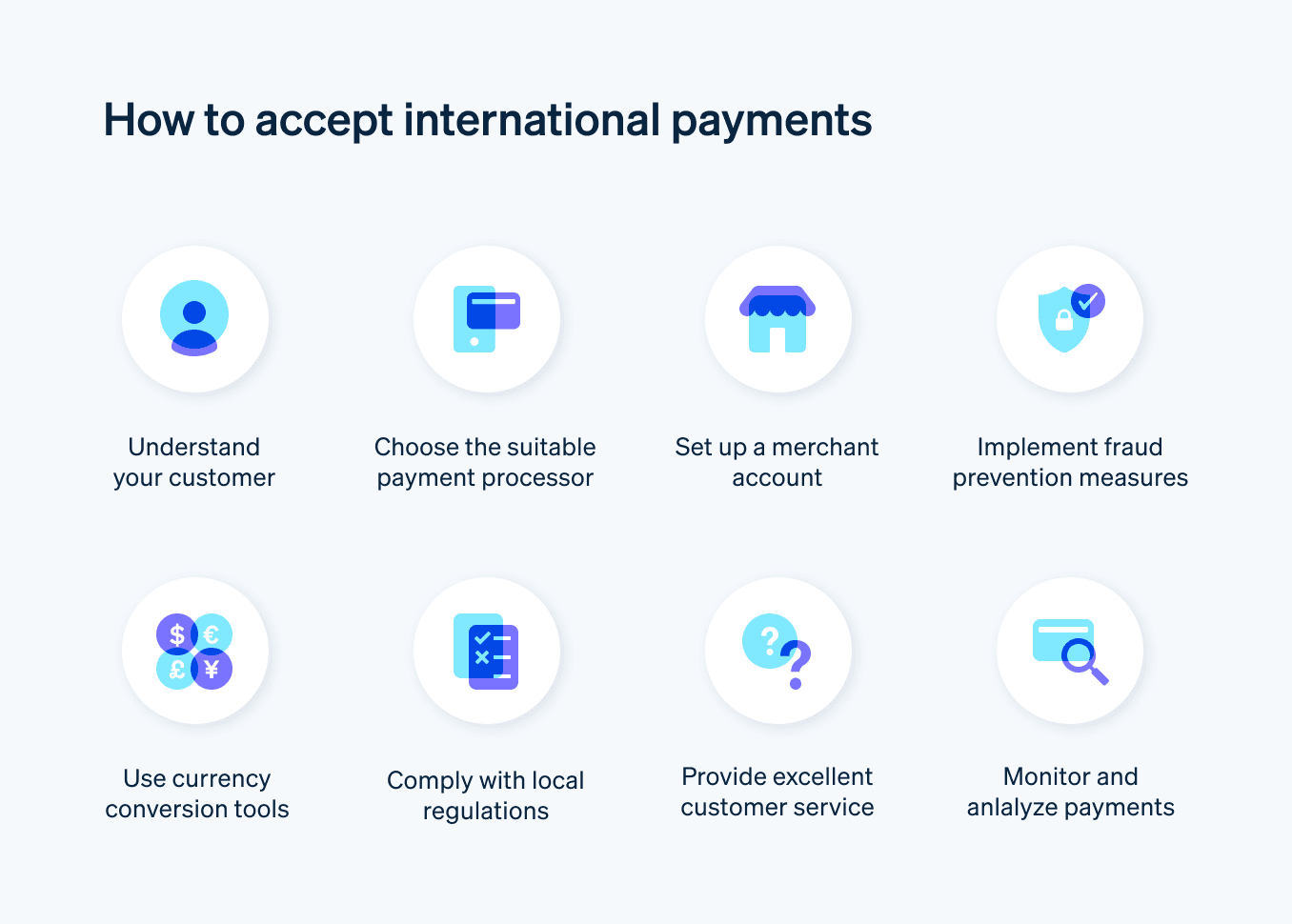由于预计到 2030 年,跨境支付将增加到超过 300 万亿美元,因此接受跨境贸易的企业拥有前所未有的增长机会。但是,跨境交易可能难以处理。企业必须解决诸如货币兑换、首选支付方式、监管合规和欺诈预防等问题。
对许多企业来说,接受国际付款所需的付出是值得的,它能促进企业在全球电商平台的长期发展。下面,我们将解释什么是国际付款、如何接受国际付款,以及您需要考虑哪些因素才能开始。
本文内容
- 什么是国际付款?
- 如何开始接受国际付款
- 国际付款使用哪些类型的支付方式?
- 什么样的企业需要接受国际付款?
- 接受国际付款的好处
- Stripe Payments 能在哪些方面提供帮助
什么是国际付款?
国际付款,也称为跨境付款 或外币交易,是指位于不同国家/地区的个人、企业或金融机构之间的资金转移。这些交易通常涉及将一种货币兑换成另一种货币。根据涉及的国家、支付方式和转账银行,这些交易可能会受到各种法规、费用和处理时间的限制。
如何开始接受国际付款
希望拓展业务并服务全球客户的企业,应考虑货币兑换、目标市场常用的支付方式、监管合规、税务和欺诈预防等问题。
以下是商家可以采取的关键步骤,用于建立一个强大且用户友好的跨境交易处理系统:

研究您的目标市场
您处理国际支付的方式,会因业务开展地点的不同而有很大差异。首先,调研 您计划服务的国家/地区中,目标受众的特定需求和偏好。这包括确定流行的支付方式、货币偏好以及任何特殊的法规或要求。
选择支付网关或处理商
选择支持目标市场常用货币和支付方式的支付网关或支付处理商。例如,Stripe 提供国际支付处理服务,包括支持超过 135 种货币。比较这些服务提供商提供的费用、汇率和功能,找到最适合您企业的方案。
设置多币种账户
如果您与支持国际支付优化和动态方式的支付服务商(如 Stripe)合作,则无需执行此额外步骤。否则,您需要开设多币种账户或使用第三方服务,以便管理多种货币,降低兑换费用,简化接收来自不同国家/地区客户付款的流程。
以当地货币显示价格
如果您的电商网站面向多个国家/地区的受众,请确保您构件的网站能以客户当地货币显示产品和服务价格。您可以使用大多数电商平台提供的货币兑换工具或插件来显示价格。
了解税收和法规
进行国际业务的公司需要了解并遵守其运营所在地的当地税务和监管要求。这些要求可能包括销售税、增值税以及任何进出口法规。确保您的企业符合这些要求,以避免出现法律或财务问题。
实施欺诈预防措施
由于跨境交易可能更容易受到欺诈的影响,因此请采取强有力的安全措施来保护您的企业和客户。
优化客户体验
货币兑换只是满足国际多元化客户群需求的一部分。认真思考您当前构建的客户旅程。您的客户群之间有什么区别?您将如何为他们每个人构建直观且方便的体验?
首先,确保您的网站和结账流程对用户友好,并在必要时提供多种语言版本。对于发货、退货和客户支持,提供清晰简明的信息。这可以与国际受众建立信任关系。
监控表现并进行调整
定期审查您的国际支付设置,分析客户反馈,并密切关注行业趋势。随时调整策略,优化客户体验,确保合规,并优化与接受国际支付相关的成本。
国际付款使用哪些类型的支付方式?
提供多种支付选项可以改善客户体验,同时增加交易成功的机会。商家应仔细权衡每种支付方式的利弊,并考虑成本、速度、便利性和安全性等因素。
国际支付的一些常见支付方式包括:
银行电汇
电汇 是一种在不同国家/地区的银行账户之间转移资金的常用方法。这种方式通常安全可靠,但汇款行、收款行以及中间行收取的费用可能会使其成本较高。处理时间从几个小时到几天不等。信用卡和借记卡
国际付款可以通过信用卡或借记卡 进行,无论是线上购物还是在实体销售点 (POS) 终端。这种方式虽然方便,但费用可能比其他方式更高,汇率可能不太划算,发卡行还可能收取境外交易费。国际支票和银行汇票
支票和银行汇票可用于国际付款,但由于处理时间较慢和费用较高,这些方式正变得越来越不受欢迎。收款人还需要在当地银行存入支票或汇票,这可能会产生额外费用。加密货币
数字货币正变得越来越受国际付款用户的欢迎。与传统方式相比,加密货币可以提供更快的处理时间、更低的费用和更高的隐私性。但其汇率波动大、监管不确定,可能是部分用户担心的问题。移动支付应用
一些移动支付应用程序(如支付宝和微信支付)已扩展其服务以支持国际付款。这些应用程序可以提供一种方便快捷的资金转移方式,但它们可能对支持的国家/地区和币种有限制,并且可能仍然会收取费用。
什么样的企业需要接受国际付款?
跨境运营的企业可以进入多元化市场,并覆盖世界各地的客户。这需要具备接受国际付款的能力,从而满足客户偏好的货币和支付方式。
通常需要接受国际付款的一些类型的企业包括:
- 电商企业
- 旅游和酒店服务提供商
- 国际服务提供者、顾问和自由职业者
- 出口商和进口商
- 教育机构
- 非营利组织
- 基于订阅的企业
- 在线电商平台
- 金融服务公司
- 物流和航运公司
近年来,支付技术的进步为更多的商家和行业提供了国际运营的机会。
接受国际付款的好处
接受国际付款可以为企业带来各种好处。这种方式可以提高潜在收入,加强品牌认知度,改善客户体验,并鼓励业务创新。通过拥抱跨境贸易,企业可以为长期业务增长和复原力做好准备。
其中一些主要优势包括:
- 获得更大的客户群
- 增加收入增长
- 竞争优势
- 增强品牌曝光度和认知度
- 让收入来源多元化
- 更深入了解客户偏好
- 更多创新,以及更高适应性
Stripe Payments 能在哪些方面提供帮助
Stripe Payments 提供统一的全球支付解决方案,帮助各种企业(从初创公司到全球企业)在线上线下以及在全球范围内接受支付。
Stripe Payments 可以帮您:
优化结账体验: 利用预置的支付界面,接入 100 多种支付方式和 Stripe Link 等数字钱包,打造流畅的客户体验,并节省大量开发成本。
- 更快拓展新市场: 具备跨境支付选项,覆盖全球客户,并降低多币种管理的复杂性和成本,可在 195 个国家/地区提供超过 135 种货币。
- 统一线下与线上支付: 整合线上与线下渠道,打造统一的商务体验,实现个性化互动、奖励客户忠诚度并提升收入。
- 优化支付性能: 通过一系列可定制、易于配置的支付工具提升收入,包括无需编码的欺诈防护功能与提高授权率的高级功能。
- 依托灵活可靠的平台加速业务增长: 采用专为弹性扩展设计的平台架构,提供 99.999% 运行可用率与业界领先的可靠性保障。
本文中的内容仅供一般信息和教育目的,不应被解释为法律或税务建议。Stripe 不保证或担保文章中信息的准确性、完整性、充分性或时效性。您应该寻求在您的司法管辖区获得执业许可的合格律师或会计师的建议,以就您的特定情况提供建议。